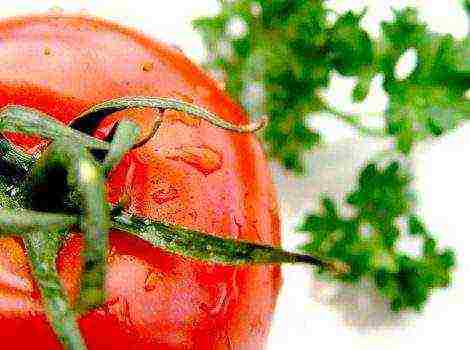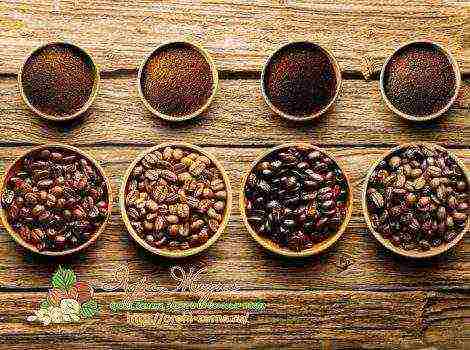Content
- 1 Features of indoor tomatoes
- 2 General characteristics
- 3 Photos and descriptions of the best varieties
- 4 Planting and leaving
- 5 The most common varieties of indoor tomatoes
- 6 Preparing the soil for planting indoor tomatoes
- 7 Planting rules for indoor tomatoes
- 8 Rules for caring for indoor tomatoes
- 9 Reviews about growing indoor tomatoes
- 10 Video: The process of growing indoor tomatoes on a windowsill
Not everyone has the opportunity to grow tomatoes in their beds for the simple reason that they do not have their own land plot. Residents of apartment buildings are deprived of this opportunity. In addition, I would like to consume my own juicy vegetables in winter, not to buy them in the store. In both cases, there is a way out - to grow tomatoes at home. It is not so difficult, and the result exceeds all expectations, since all year round with its own tomatoes. But in order to start planting and growing a plant, you need to choose a variety of the best indoor tomatoes. Currently, there are quite a lot of them.
Features of indoor tomatoes
- Of course, not every variety of tomatoes can be grown at home. There are a number of criteria under which indoor plants develop normally and produce a good harvest.
- These varieties are mainly related to standard ones. That is, they have a powerful stem, a dense crown, they do not need to be tied up, to perform any operations to form the correct bush. Everything helps to ensure that there is a bountiful harvest.
- Such tomatoes should be short, because they grow in a confined space (pot, box), where there are not many nutrients. Therefore, only undersized plants have a chance to bear fruit.
- Another feature of growing in an apartment is a lack of light, especially in winter. Indoor tomatoes are adapted to this so that they develop well without additional lighting.
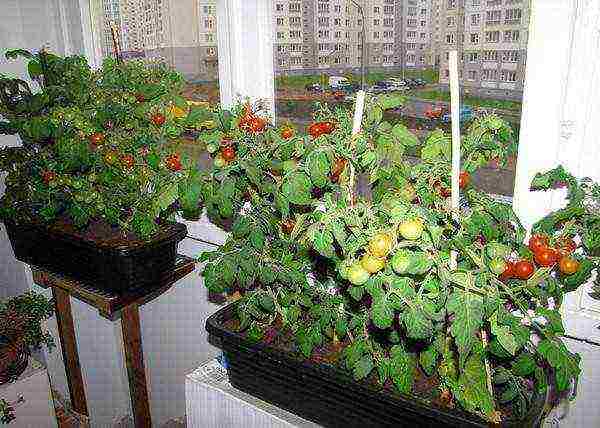
It is also important that these varieties are resistant to the most common diseases, such as leaf mold.
Among indoor varieties, there are those that are grown as ornamental plants, this must be borne in mind when choosing tomatoes. Ornamental ones bear little fruit, they are small, although edible. If the planting is carried out precisely for the purpose of obtaining a good harvest, then it is necessary to select the appropriate varieties.
General characteristics
The description of each variety has its own characteristics of a particular tomato. However, a number of characteristics for indoor tomatoes have common features:
- very tasty, contain a lot of sugar and vitamins;
- fruits are small in size from 15 to 130 g., often tightly stick to the bush, and per year they can bring up to 2 kg of tomatoes (from the bush);
- These tomatoes are perennial, after harvesting, leaves appear on the stems after a while, the lifespan of such tomatoes is five years, all this time they can bear fruit, but the largest harvests are harvested in the first two years.
Indoor tomatoes perfectly adapt to the home environment, and the listed characteristics indicate that there will always be juicy, nutritious fruits on the table throughout the year.
Photos and descriptions of the best varieties
The number of varieties of this type of tomato is not as large as that of ordinary tomatoes, but there are also a lot of them. Every year breeders develop new varieties or get another hybrid with improved characteristics. You can make a list of the most common varieties that are most often grown by indoor plant lovers. First of all, we list the standard varieties.
Teeny Tim. Bred in the Netherlands. Its height is 30 cm, if planted in the ground, it grows up to 50 cm. Fruiting throughout the year. Fruits are spherical, red, weighing 12 to 14 grams.This is not to say that these tomatoes taste too sweet.
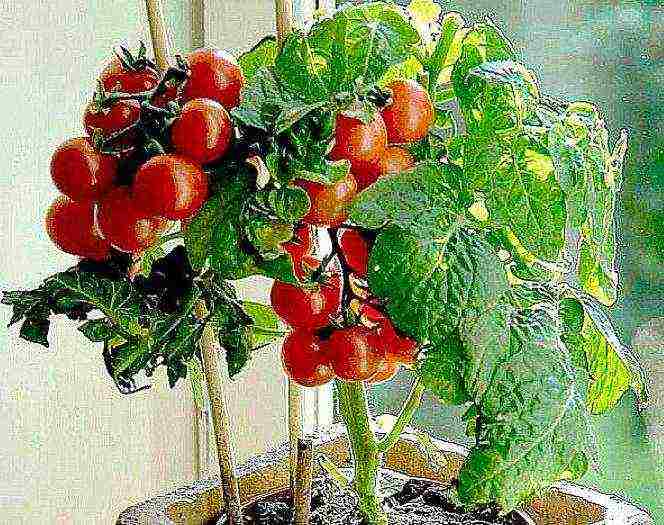
Window yellow. This is a novelty in the tomato seed market. Its very name suggests that the fruits of this plant are yellow. It tastes very sweet. During the ripening period, they tightly stick around the branches of the tomato, their weight is 30 grams, and the plant height is 25 cm.

Bunch of honey. Another variety of yellow tomatoes, perfectly suited for growing, both on the windowsill and in the open field. Height 40 cm, yellow fruits form on the branches and really look like bunches of grapes. It has a high yield, and the fruit has a very thin skin and a sweet taste.
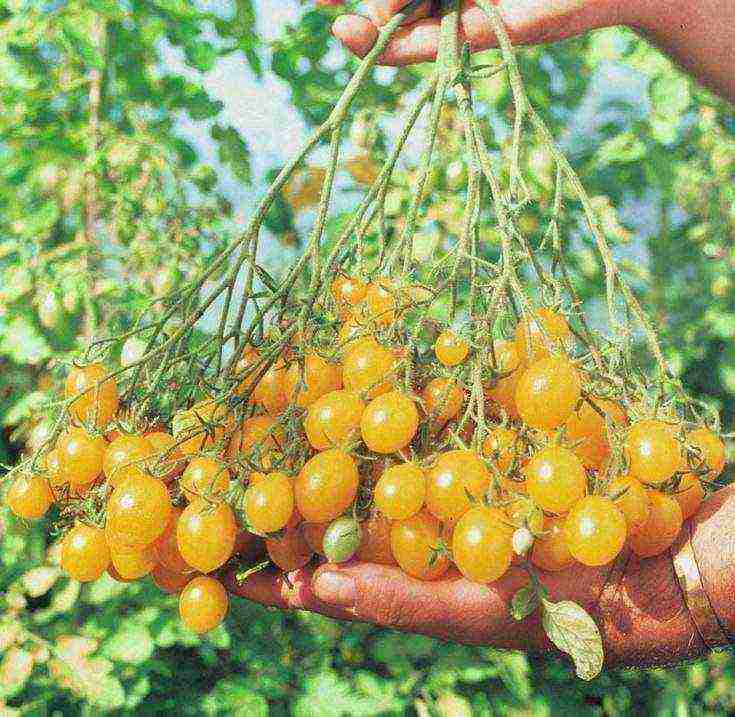
Florida Petite. It bears fruit well in winter. Fruits are red in color with very sweet pulp, weighing no more than 40 grams. This variety is valued precisely for its high yield. Ripening fruits are collected in dense clusters, so that the leaves themselves are not visible.
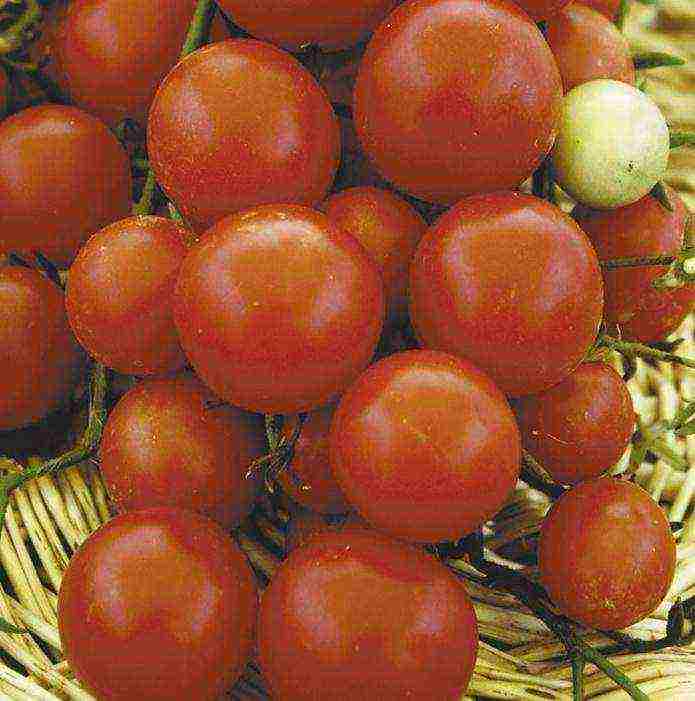
Pygmy. This variety can be easily attributed to an ornamental one, but the plant bears fruit quite abundantly, although the fruits are small, about 25 grams, there can be both yellow and red tomatoes on the branches. Well adapted to short day conditions, this does not affect its development.
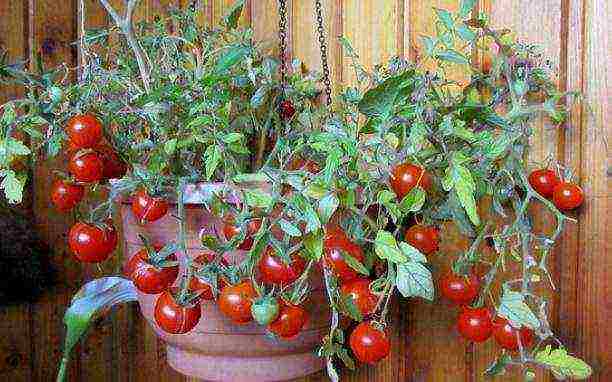
Pinocchio. Just a versatile variety, with dense foliage and many red fruits, and although they are small only up to 20 grams, up to 2 kg of these fruits can be harvested from one bush, which are great for salads, and also go well in salting. The moderately sweet taste of these tomatoes makes it indispensable in winter when you want fresh vegetables. In the summer, the plant can grow in the beds, in the fall it is transplanted into pots and it develops at home, bearing fruit in the winter.
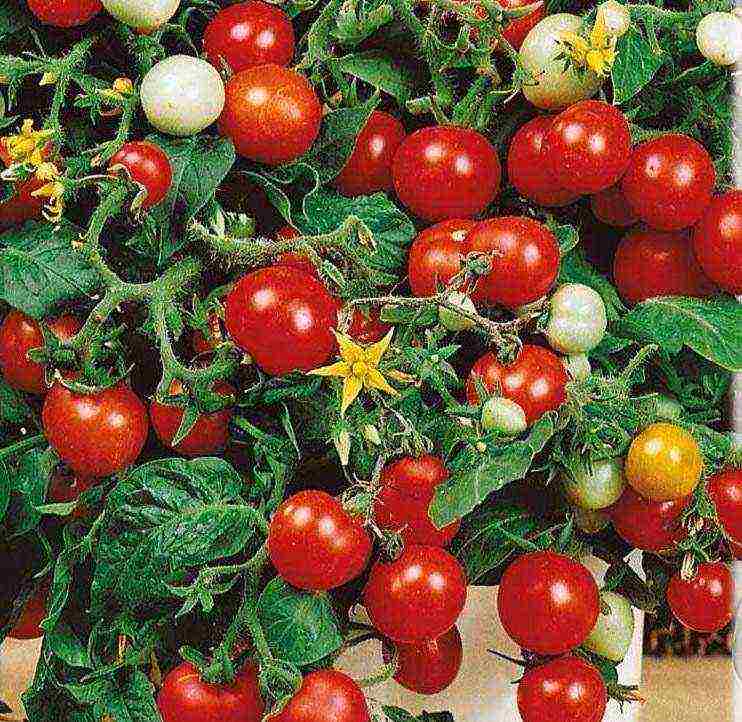
Micron NK. The smallest of all existing indoor tomatoes. Its height is no more than 15 cm. It fits into an ordinary flower pot. Fruits of yellow and red color are very small, one might say peas, weighing 10 - 15 grams. The harvest of these tomatoes is small, but fresh, sweet tomatoes are on the table all year round.
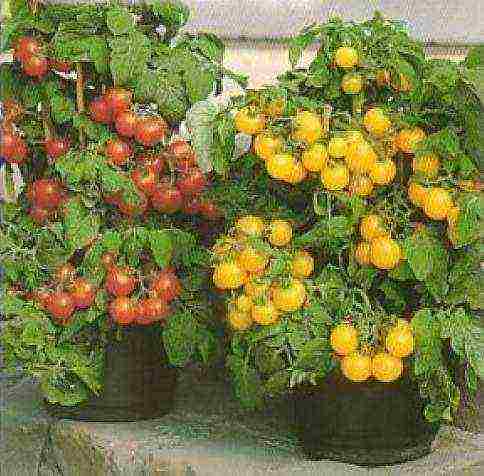
Bonsai. A very neat, low bush (up to 30 cm) grows from the seeds of this tomato variety, which can be easily placed in an ordinary flower pot. Fruits are bright red, weighing 25 - 30 grams, spherical. With good care, 1 kg of tomatoes can be harvested from the bush during the year.
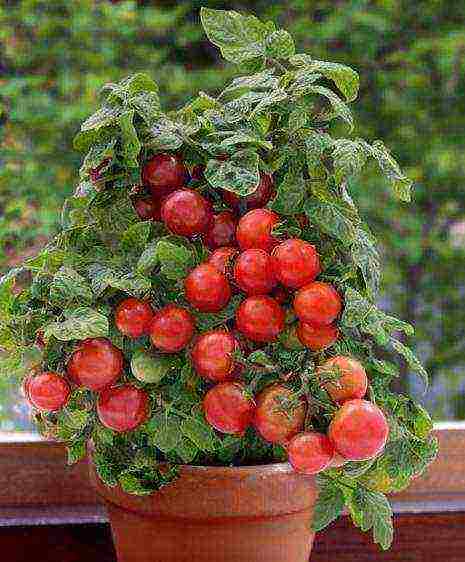
Room surprise. Refers to early ripening varieties. Fruits are red, elongated with fragrant, sweet pulp weighing up to 30 grams. Unlike the listed varieties, which are capable of producing crops even in a short day, this tomato needs lighting in winter, otherwise there will be no harvest in winter.
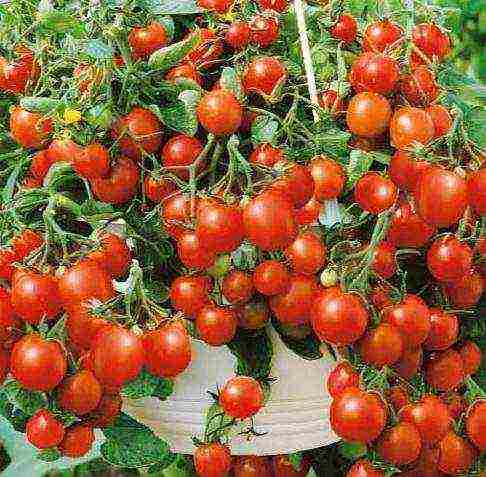
Balcony miracle. The name was not chosen by chance. It grows up to 50 cm and bears fruit all year round, does not require good consecration. Its round fruits are the largest of all indoor tomatoes up to 100 grams. weight, if you take good care of it, 2 kg of tomatoes can be harvested from one bush per year.
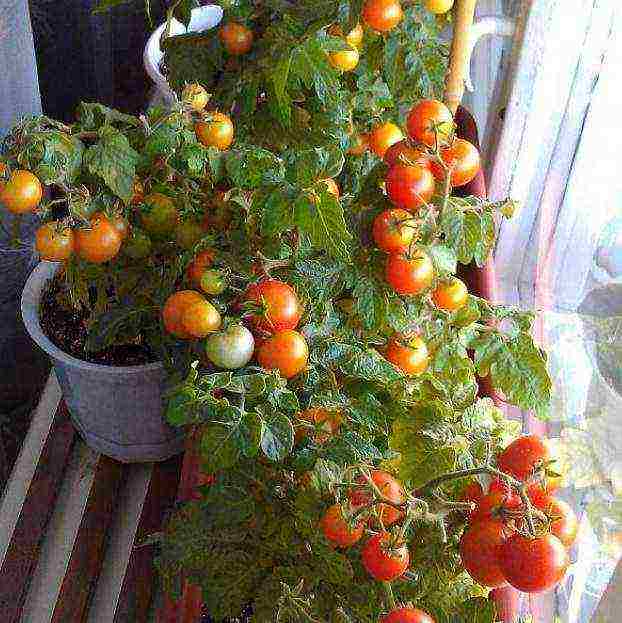
Garden Pearl. This variety belongs to ampelous, they are planted in pots or pots, from which, as the plant grows, shoots hang down. These tomatoes have a very decorative look. Their yield is lower than that of standard ones, it is more difficult to care for them, but on the other hand, these tomatoes have an excellent taste and they become a decoration of the house. From the seeds of the Sadovaya Zhemchuzhina variety, a bush grows up to 50 cm tall with thin, but very strong stems, on which round raspberry-colored fruits with a very delicate skin ripen, so that they seem transparent. Fruit weight 15-20 gr.

Citizen F1. This is a hybrid bred exclusively for indoor growing conditions. It can be held upright by tying up the stems. Red, round tomatoes reach a weight of 30 grams.

Cherry Fingers F1. Another hybrid not long ago bred. Its strong shoots reach a length of 50 cm. Elongated, red fruits are collected in clusters with 8-10 tomatoes weighing up to 30 grams. From one bush, you can get 2 kg of tomatoes, but only with good care.
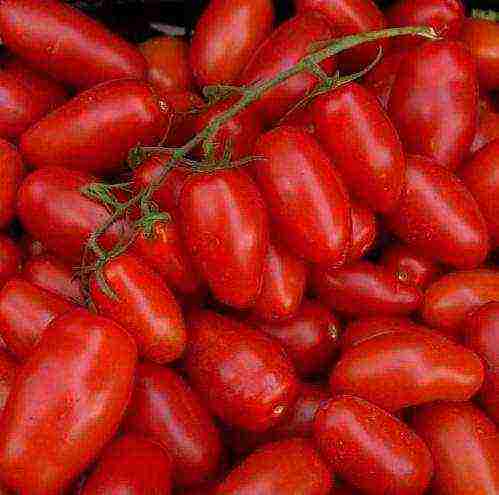
Toggle switch. The branchy bush of this tomato yields 2 kg of small red fruits weighing up to 20 grams, belongs to the superearly ampelous varieties. Possessing good fertility, it, at the same time, looks very decorative, that is, it brings benefits and creates beauty.
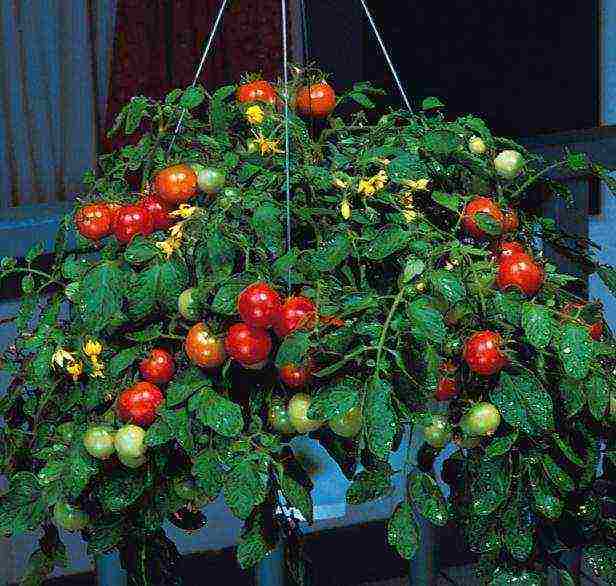
Mascot. The result of the work of Russian breeders. Shoots reach a length of 55 cm. The fruit is red, looks like an egg, the weight of one tomato is up to 40 grams. But if you plant a plant in the ground, then the mass of one tomato will reach 80-100 grams.
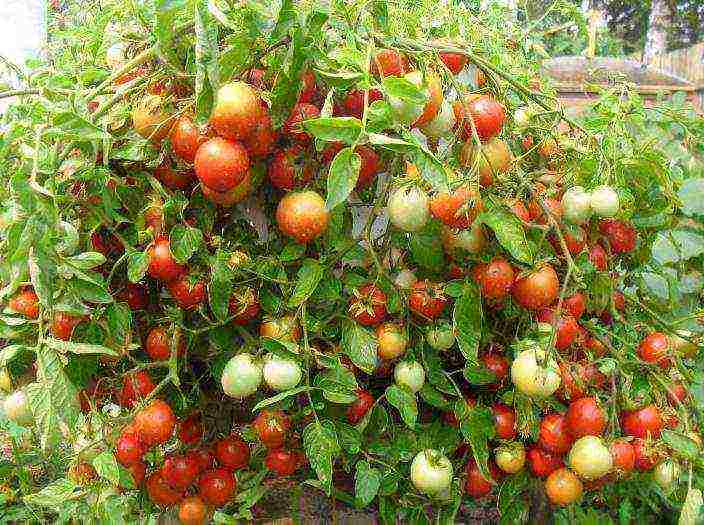
Red abundance. The shoots of this tomato grow up to 60 cm, while growing quickly, so this must be taken into account, since the plant will take up a large space in the room. Fruits are collected on clusters, one can contain up to 12 pieces. They are round, deep red in color, weighing 20 grams. everyone. An important circumstance should be taken into account when growing tomatoes of this particular variety - additional lighting is needed in winter, if, of course, the goal is to get a good harvest in winter.

Planting and leaving
There are some peculiarities associated with growing indoor tomatoes. Like ordinary tomatoes, they are grown using seedlings, but one must take into account the fact that indoor tomatoes begin to bear fruit after 100 days, which means that seeds should be sown in pots in September, if we want to get a harvest in January, just in time for the New Year's table.
Before the seeds are planted, they are dipped in a weak solution of potassium permanganate for 15 minutes to destroy possible viruses. Then they are laid out on a napkin and within about two days they germinate.
Seeds are sown in a box filled with earth. Alternatively, you can buy a special seedling substrate in specialized stores. Seeds are planted to a depth of no more than 1 cm, the distance between the planted seeds is from 2 to 3 cm, this is done in order not to thicken the seedlings too much.
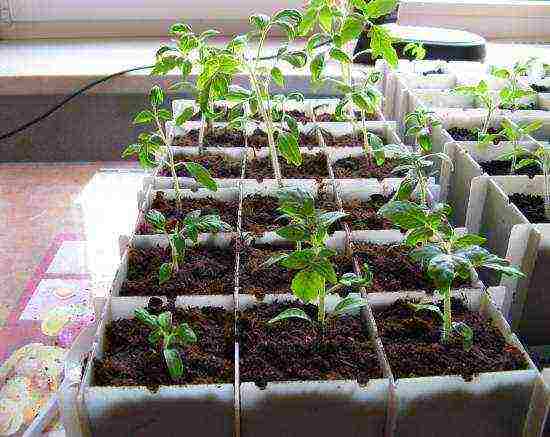
As soon as the sprouts reach such a position, when they have 2-3 leaves, they are planted in pots or other containers. Their volume depends on the variety. For Bonsai, a volume of no more than 1-2 liters is suitable, but ampelous varieties require a volume of up to 5 liters. It must also be remembered that the bottom of the pots must be with holes, this is a prerequisite.
The next point to which you must definitely pay attention is the soil. The fertility of the plant directly depends on it. For indoor tomatoes, you need to pick it up in the following proportions:
- garden soil 5 parts;
- sand 2 parts;
- compost 5 parts;
- peat 1 part.
Urea, potassium sulfate and wood ash are added to this mixture, all in the volume of one matchbox. Having prepared the ground, you can start planting seedlings:
- the bottom of the pot is filled with a drainage layer - gravel, expanded clay, then soil is poured, a small depression is made in the center;
- seedlings, before planting in pots, are watered, carefully dug out so as not to damage any part, and planted in pots, after which they are watered again, it is necessary that the earth is well saturated, this is a guarantee that it will fall on the roots;
- pots with seedlings are placed on the windowsill on the south side of the room, lighting is needed in the evenings, and it is also required on cloudy days;
- after a week, fertilizing is applied - nitrogen fertilizers, they are necessary for plant growth;
- when the tomato blooms, to promote pollination, the stems are shaken and a small brush or feather is drawn over the flowers;
- when ovaries appear, potash fertilizers are applied at least once every two weeks;
- in cases where it is necessary to form a bush, cut off the extra stepsons, remove the inflorescences that are superfluous, all this increases the fertility.
- too tall bushes tie up.
General recommendations for plant care are to loosen the soil, water it at least twice a week, but never water it. When the plant begins to bloom, watering stops. Every ten days, apply top dressing in the form of mineral fertilizers or manure diluted in water.
In order for the air next to the tomato to be moist, a glass of water should be placed near the pot with the plant, this will be enough to humidify. It is best to remove only reddening fruits from the branches, then they will ripen.
When a fungal disease occurs, the entire plant is sprayed with phytosporin or another antifungal agent. If the goal is to have tomatoes all winter, then you need to constantly make sure that there are no ripe fruits and dry leaves on the branches, all this must be removed in time and then the indoor tomato will delight you with good harvests almost all year round.
It is quite possible to grow indoor tomatoes at home. Not only as an ornamental plant, but also a real help in the household. Modern varieties allow you to grow plants that bring a bountiful harvest both in winter and summer, and on the table, even in the most severe frosts, have a delicious and sweet tomato. In addition, these tomatoes are great for preservation.
We want vitamins all year round, but not everyone can afford to buy vegetables often in winter. Tomatoes are packed with nutrients, but how can you provide your entire family with enough of these delicious red fruits?
The answer is simple - grow at home. Yes, indoor tomatoes are a reality, but not all types of this plant are suitable for obtaining a good result. So which cultivar is suitable for growing on a windowsill?
Indoor tomatoes and the best varieties for home
It is best to grow on the windowsill dwarf self-pollinated tomato species with low stalk growth. Tomato varieties with high stem growth are most often grown in greenhouse conditions over a large area of soil. On the windowsill, tall varieties may not mature, because these plants have powerful roots, they simply do not have enough nutrients in a small pot volume.
However, if you build additional racks and prepare sufficiently voluminous containers, then even tall tomatoes can be suitable for getting a good harvest at home, but for this you also need to choose certain varieties.
This group includes cherry and cocktail tomatoes with small fruits, these plants are early maturing and undemanding. Let's take a closer look at the balcony varieties of tomatoes.
to content ↑ Low-growing varieties of tomatoes
- Moneybell, Tiny Tim, Florida Petite
These are early maturing varieties with low stem growth, the fruiting period lasts about 2.5 weeks, often all the fruits of a rich red hue ripen at the same time.
Miniature bushes form the first flowers at the level of 5-7 leaves, the next inflorescences are formed 1-2 leaves higher. When 2-4 flowers bloom on the main stem, the plant no longer grows in length, a step-son is formed.
This type of plant is called determinant.
5-8 small round fruits can grow from flowers.
- Angelica
A fairly popular variety for growing on a windowsill, since it ripens quickly enough.
As in the previous varieties, the growth of the stem stops after the formation of three inflorescences on it. 7-10 tomatoes of a long pointed shape are formed from each flower, the fruits are relatively large and bright red.
- Pearl
These undersized bushes are very convenient to grow on a windowsill. The plant is unpretentious in all respects, it is resistant to temperature fluctuations, to a lack of moisture and nutrients in the ground.
4-7 small smooth tomatoes are formed from the flowers. The fruit has a slightly elongated shape and a pinkish-crimson hue.
back to content ↑ Tall varieties of homemade tomatoes
Cocktail tomatoes for the balcony
- Butterfly
A tall bush can reach 150 cm in length. Unlike previous varieties, this plant (indeterminate) has a stem that continues to grow regardless of the number of flowers in full bloom.
From each inflorescence 25-50 tomatoes are formed. Fruits are small, bright crimson, their shape is ovoid.
- Ballerina
The main shoot reaches a length of 150-180 cm.
The plant is indeterminate, the inflorescences are simple, on each of them 5-8 medium pink pear-shaped fruits are formed.
- Romantic
On the windowsill, this bush with a high stem of 150 cm or more can bring a good harvest.
7-10 tomatoes are formed from one flower. Fruits are round or flattened, rather large, their color is red with a yellow-brownish tinge.
Cherry Tomatoes (Cherry)
- Red
Mid-season plant with medium-sized stem. The shoot length is not limited by the number of flowers.
The inflorescences have the original shape of a long whip, on which many miniature red fruits are formed.
- Yellow
Plants are mid-season determinant. Can be grown both on a windowsill and in a vegetable garden in film shelters.
4-6 flowers are formed, after the growth stops. Inflorescences of intermediate or simple type, from which many small round yellow fruits are formed.
- Pink
Bushes taller than 150 cm, indeterminate. On the inflorescences, 14-25 ovoid miniature fruits of a pinkish hue are formed.
The following varieties of tomatoes are also suitable for growing a house on a windowsill: Bonsai, Pinocchio, Bonsai-micro F1, Balcony Miracle, Balconi Yellow, Cherry Yasik, etc.
to the content ↑ Necessary conditions for growing indoor tomatoes
Temperature and lighting
Tomato loves warmth and light, so it is better to put containers on the south and east windows.
The optimum temperature for growing is 21-25 degrees.
In the summer heat, be sure to make sure that the tomatoes on the balcony do not overheat and are not under the burning direct rays of the sun.
In winter and on a poorly lit windowsill, it will be necessary to artificially illuminate the bushes with a phytolamp.
Watering and feeding
Balcony tomatoes are watered about once every 2-4 days with a sufficient amount of settled water at a comfortable temperature.
For watering, it is better to use a watering can with small holes so as not to damage the rhizomes of the plants with a strong stream.
After the formation of 2-3 leaves, organic fertilizers can be added to the soil along with watering, then the bushes are fertilized once every 2-3 weeks.
When the tomatoes bloom, organic fertilizers should be replaced with mineral fertilizers.
Soil mixture and pot
There are special earthen mixtures in stores with a sufficient amount of nutrients. The soil can be prepared independently from ordinary garden soil mixed with sand.
But such a soil substrate should certainly be disinfected with hot water with manganese, you can still ignite the soil.
For planting seedlings, small containers are needed: plastic glasses, peat pots, cut bottles. However, if you do not do a pick, then you will immediately need a volumetric container of at least 5-7 liters, for example, flower pots or wooden boxes.
back to contents ↑ How to plant and grow tomatoes on the windowsill?
Seeds of the selected variety need to be processed for better biting. For this, the seed is soaked first in a manganese solution for 20-30 minutes, and then in growth stimulants for 8-10 hours. The seeds can then be germinated warm in a damp cloth, although this procedure can be dispensed with.
Seed is planted to a depth of 1-1.5 cm, retreating from each 3-4 cm. Containers with seeds are covered with polyethylene and placed in a warm place. When shoots appear, the greenhouse is removed and the seedlings are rearranged in a lighted place.
At night, the temperature should not drop below 15 degrees, and during the day - rise above 28-30.
Seedlings should not be filled with water and left in a draft so that they do not get sick.
After the formation of 2-3 leaves, the plants can be fed by applying fertilizers with watering. When the bushes grow up, they are transplanted into a larger pot, if the seeds were originally introduced in a small container. If long boxes are used for picking, then an interval of at least 25 cm must be made between seedlings.
Further, plant care takes place according to the standard scheme.We must not forget about regular watering and supplementary lighting with a phytolamp if you want to get a good harvest.
If you chose the variety where stepchildren stems are formed, then they need to be removed.
Self-pollinated varieties will not be a hassle, but others will need to be pollinated on their own with a soft brush or cotton swab. You can read more about this in our article.How to pollinate tomatoes at home.
At the end of the fruiting period, ripe tomatoes must be picked immediately so that the still unripe fruits develop better.
As you can see, it is quite possible to get a good harvest of tomatoes at home. Experiment with varieties and choose the best options! Good luck!
Similar articles:
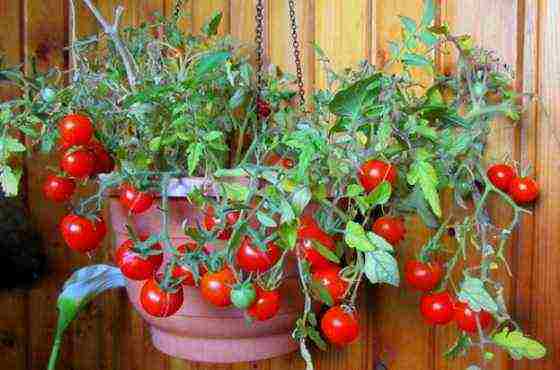
Indoor tomato is an excellent development of breeders. The culture can be grown at any time of the year on your windowsill. Today we'll talk about how to grow indoor tomatoes to enjoy fresh fruits during the winter cold.
The most common varieties of indoor tomatoes
For growing on a windowsill, the following varieties of indoor tomatoes are suitable:
- Balcony wonder-ripening, standard bushes up to 0.5 m tall. Forms sweet red, round-shaped babies. The plant perfectly tolerates a lack of lighting, and is excellent for the winter period.
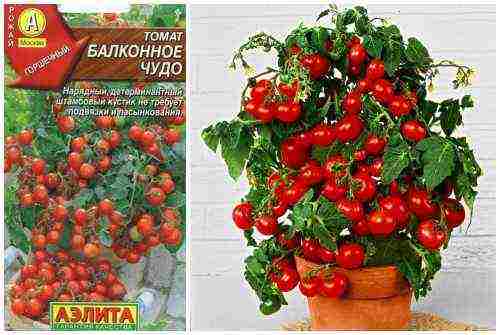
- Room surprise - early maturity. Height up to half a meter, and the fruits are bright red and oblong. In cold weather they require additional light. You can buy 0.1 g for 16-25 rubles.
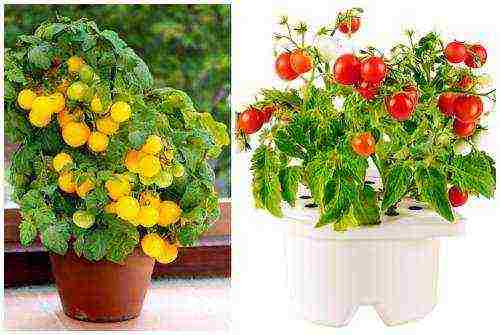
- Pinocchio is considered to be one of the best varieties for growing in pots. Height - up to 30 cm, and the weight of one fruit can reach 20 g. Harvest from one bush - 1.5 kg. 20 pieces cost 12 rubles.
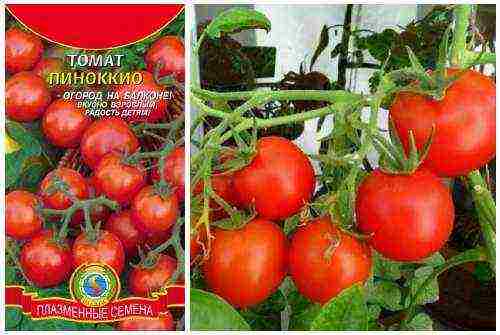
- Micron NK is a cherry variety that bears fruit with tomatoes up to 15 mm in size. This option is decorative and does not depend on the duration of the day. Price 10 pieces - 13 rubles.
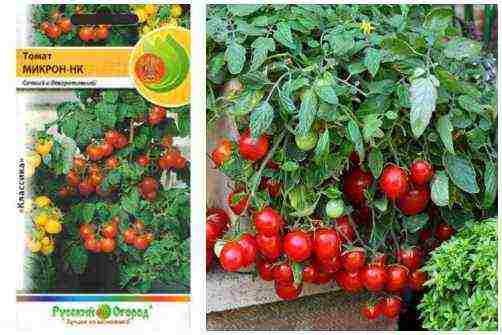
- Florida Petite is characterized by high fruiting. The height of the bush is up to 30 cm, and the tomatoes grow in weight up to 40 g. 0.1 g - 15 rubles.
- Sadovaya Zhemchuzhina is an ampel-type indoor tomato with a shoot length of up to 20-40 cm. It features thin stems that can withstand numerous fruits. Does not require pinching, and each bush gives up to 300 fruits. A sachet of 0.1 g costs 12 rubles.
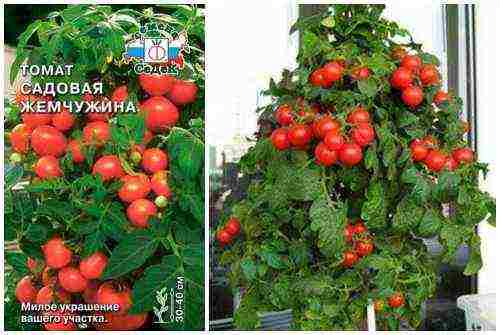
- Talisman - will give fruits up to 40 g in weight. Bear fruit abundantly and for a long time. 0.1 g - 12 rubles.
- Japanese indoor tomato - the seeds of this variety were delivered by diplomats from Tajima province, Japan. From germination to fruiting - 110-120 days. Fruits grow up to 50 g. A package of 10 seeds costs 38 rubles.
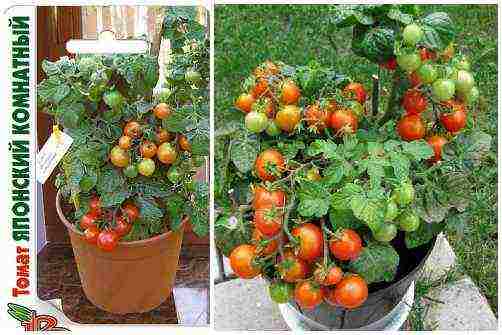
Preparing the soil for planting indoor tomatoes
These crops prefer soil with humus impurities, and the consistency should remain permeable and moist. The composition of the mixture looks like this:
- meadow or forest land - 5 parts;
- compost (rotted) - 5 parts;
- sand - 2 parts;
- peat - 1 part.
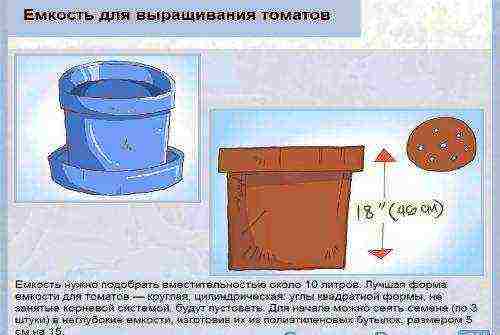
Important! Land from a garden or forest should only be used after thorough disinfection.
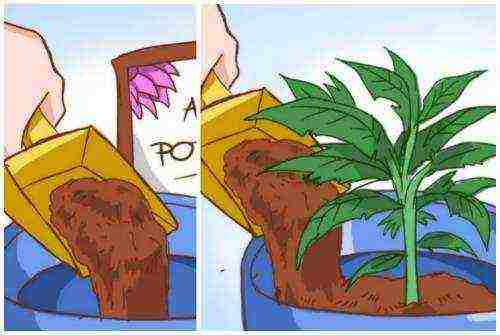
Growing tomatoes in winter on a windowsill takes place in limited conditions, therefore it is recommended to ensure the maximum supply of nutrients to the plant. This can be done by applying a complex of fertilizers. On a bucket of soil: a handful of wood ash, 10 g of urea, 40 g of superphosphate and 40 g of potassium fertilizer.
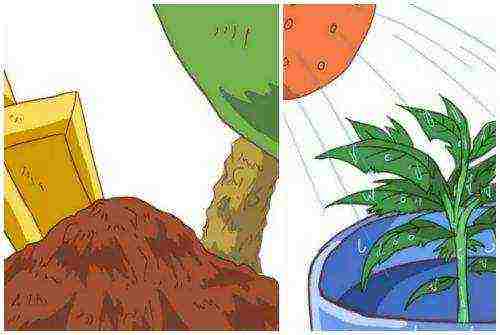
Planting rules for indoor tomatoes
The technology of growing tomatoes provides for a preliminary check of seeds for quality. To do this, immerse them in a medium strength saline solution for 2-3 hours. Choose those instances that have sunk to the bottom. The procedure for a 20-minute soak in potassium permanganate ensures the disinfection of the seeds.
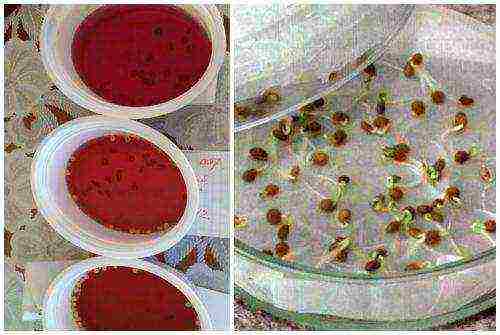
Wrap the dropped seeds in a soft, damp cloth and leave for 3 days. During this time, sprouts should hatch from the seeds.
Important! Calculating when to plant tomatoes is easy. Remember that fruiting will begin about 100 days after the first seedlings hatch.
To grow tomatoes on a balcony or windowsill, choose:
- for dwarfs - 2-liter containers;
- for ampelous - 4-liter.
Provide drainage holes for each pot.
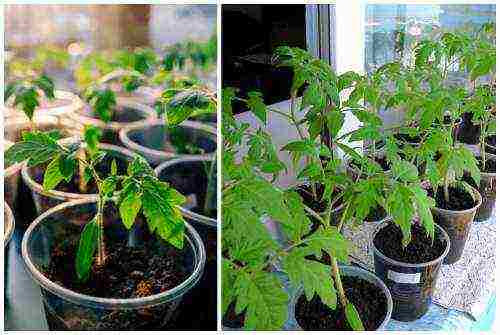
Planting seeds at home is done in this way:
- A distance of 3 cm is left between the seeds, and you need to sow to a depth of about 1 cm.
- After that, the soil is watered, covered with a film and placed in a place with a stable temperature of 25 degrees.
- When the first shoots appear, move the containers to a cool place and limit watering.
- As soon as 2-3 leaves appear on the sprouts, transfer them to a permanent place of the future location.
Rules for caring for indoor tomatoes
In an apartment, you should take care of crops especially carefully.
Humidity and temperature
- Eliminate temperature fluctuations. The required daytime range is 20-25 degrees, and at night the optimum temperature is 18-20 degrees.
Important! When the temperature rises or falls outside the normal range, it will slow down the processes of photosynthesis in the leaves.
- The temperature rise is provided by turning on the heaters, and cooling by ventilation.
- Optimum humidity is not higher than 60%. Excess will lead to the development of fungal diseases. The foliage grows well, but there is no ovary.
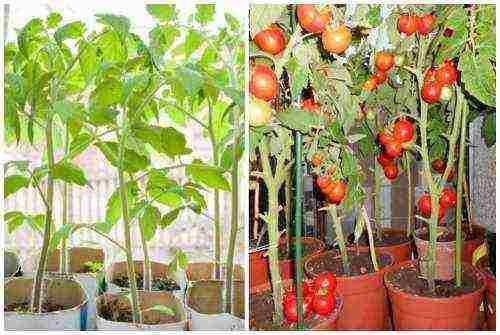
Organization of optimal lighting
- Growing tomatoes on a windowsill involves the creation of a certain lighting system. When growing light-deficient tomatoes, the shoots will become thin and tall.
Important! The optimal daylight hours are 13-16 hours.
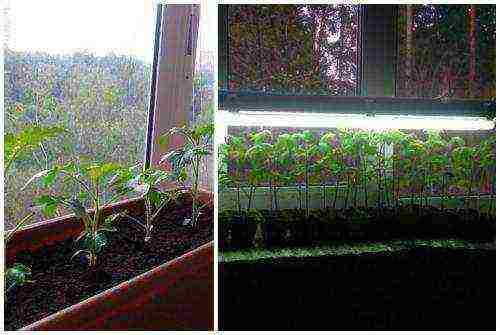
It is better to take the south side for the culture, and if there is a lack of light sources, it is necessary to equip additional lighting there, at a distance of about 30 cm from the bushes. To provide illumination, the following lamps are applicable:
- Sodium - will give a warm light of orange hue. Power - 70 W. The disadvantage is that you need a regulating device, it has large dimensions and a high price.
- Phytoluminescent - durable and economical option. The disadvantage is pink and lilac radiation, which is suitable for culture, and not entirely acceptable for human eyes.
- LED is the best option. High efficiency, durability and the possibility of spectrum correction.
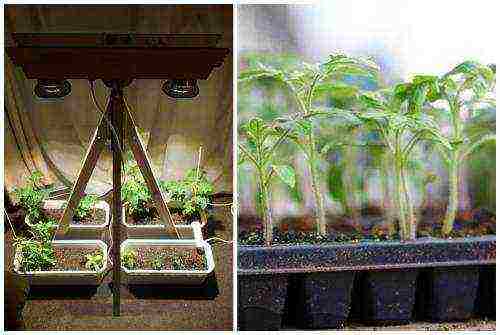
Features of crop watering
- In the early stages, the first 30 days, regular watering is necessary. The intensity decreases over time. During the growing season, water the crop every 3 days.
- The water should be warm and settled. The culture tolerates excess moisture worse than lack of moisture. The need increases with the appearance of the fruit.
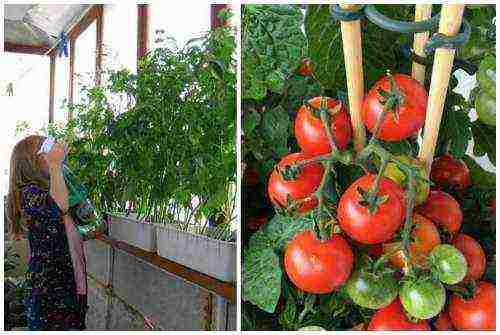
- If there is a dry period, then serve water in several doses with a small amount of water.
- When planting in boxes, the soil is watered around the bushes. Feeding directly under the stem will expose the roots and damage them.

Top dressing of tomatoes
- Fertilization will ensure normal growth and fruiting.
- To begin with, feeding is done with a solution of a mullein in a ratio of 1/5, but not before the plant is planted in a permanent place.
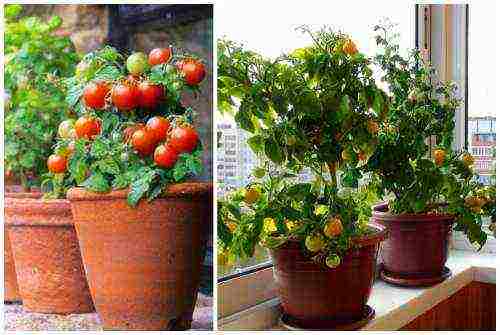
- The following treatments are carried out at intervals of 10 days. Take 5 liters of superphosphate + 1 g of potassium sulfate, dissolve in 1 liter of water, and the root is poured into the composition. When inflorescences appear, any nitrogen fertilization should be excluded.
- When 2 and 3 inflorescences appear, the tomatoes are sprayed with a solution (1 g of boric acid + 1 L of water). And suitable biostimulants.
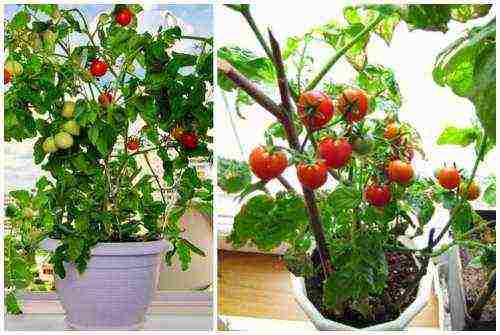
Interesting! To stimulate pollination, periodically shake the inflorescences or pollinate with a regular paint brush.
How to form a bush
- In medium-sized species, 1 stepson is left above the first flower tassel, tying him to a support. The undersized have 2 stepsons.
- As they lengthen, the stems are tied to stakes. Shoots in the axils are removed, as are the yellowed leaves.
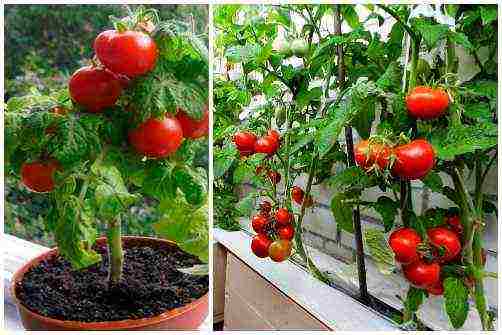
Reviews about growing indoor tomatoes
Reviews about growing different varieties of tomatoes:
- Alena: I tried to raise Pinocchio. Germination is good, almost 100%, but some frail bushes. It seems that they also tried the tomatoes, but I was constantly worried that they would disappear. By the way, she pollinated herself with a brush.
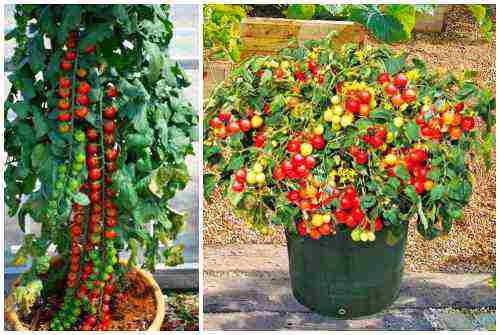
- Olga: I planted a room surprise. I did not even expect such a stormy return of the harvest. It is not only delicious, but also looks insanely beautiful.
- Mila: And my Talisman for some reason disappeared ... It's a shame, because it seems that I followed all the recommendations. But I'm not discouraged, I'll just try something different, maybe I'll switch to indoor cucumbers.
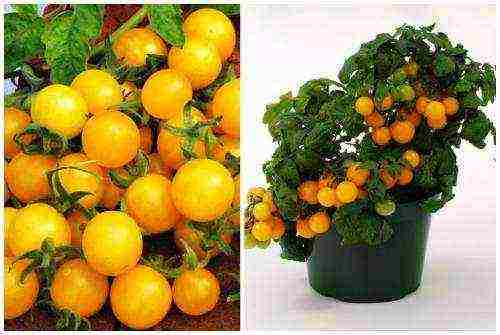
It is quite possible to get a decent harvest from the windowsill, you just have to follow the rules for planting and growing tomatoes. You can share your experience in organizing a garden bed on a windowsill in the comments.
Video: The process of growing indoor tomatoes on a windowsill
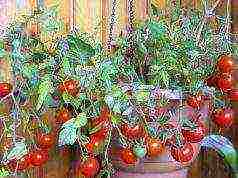
Tomato is one of the most popular vegetables in the world. Traditionally, we are used to seeing fresh tomatoes in the summer. However, it is possible to grow tasty and healthy fruits in winter, even without a greenhouse. For this, special indoor varieties of tomatoes were bred. They are not inferior to their summer counterparts in taste and vitamin value. However, they have their irreplaceable advantages. Because indoor tomatoes, they grow quietly in pots, like house flowers. Tomatoes have an excellent decorative appearance and bring a good harvest (for a houseplant). They are small and look more like a delicious fruit than a vegetable we are used to. Indoor tomatoes bear fruit well in winter, so you can always have a sprig of tasty, healthy and juicy fruits for your culinary needs.
Variety selection rules
Although at first glance it may seem that growing indoor tomatoes is no more difficult than caring for home flowers, this is not the case. However, if you follow some simple rules, starting with the choice of a suitable variety, you can achieve a positive result. Here are some criteria for choosing your future pet:
- You should take into account your conditions and opportunities. As with an ordinary vegetable garden, desire alone is not enough. Choose varieties that can take root and bear fruit in the environment that you create for them at home.
- Not all people are able to cope with pinching and bush formation, therefore, the variety must be standard. Such tomatoes are single-stemmed and look like a small tree that does not require a garter and support.
- In flower pots, space is limited, but undersized varieties are able to survive in such confined conditions. Low tomatoes can yield up to 1.5-2 kg of yield per plant.
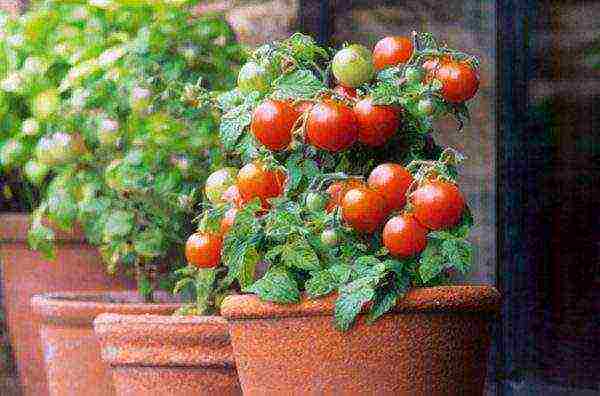 There are tomato varieties that can take root in flower pots.
There are tomato varieties that can take root in flower pots.
- Tomato must be hardy to resist disease and limited conditions (lighting, heating). Therefore, most indoor vegetables are hybrids. They are more resistant to such conditions, but they are not able to maintain these qualities in subsequent generations.
Popular varieties
Choosing this type of tomato, you must be very careful at the stage of selection and planting. Then, in the subsequent stages, leaving will not bore you much, and the plants will not cease to please the eye and bring a decent harvest. Next, consider a few examples of indoor varieties. They differ according to different criteria, but each of these tomatoes has its own special qualities.
Cherry
The cherry variety has a number of advantages compared to ordinary tomatoes and its indoor brothers:
- The shelf life is much longer. They are not susceptible to cracking and do not deteriorate during transportation / long-term storage.
- Cherries grow in clusters. This facilitates the process of harvesting, transporting and storing.
- These tomatoes have a richer and sweeter flavor.
- Cherry color is varied, which has a positive effect not only on their taste. But also from a decorative point of view, this abundance of shades is pleasant.
- These tomatoes have pronounced dietary properties.... They help with metabolism, protect against early aging, are beneficial for the cardiovascular system and can prevent cancer.
- The small size of the fruits allows them to be used to decorate culinary dishes... And also for its diminutiveness and sweet taste, children love this tomato.
- Because of the shallow root system, cherry can be grown in a pot at home.
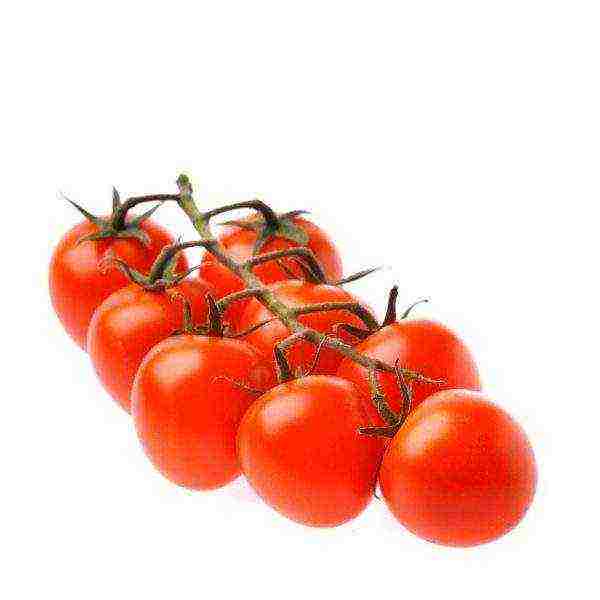 Cherry Tomatoes
Cherry Tomatoes
Cherry is a determinant, indeterminate and semi-determinant plant.
| Stem length, meter | Fruit weight, gram | |
| Determinant | 0,4 – 1 | 7 – 15 |
| Semi-determinant | 1 – 1,8 | 15 – 25 |
| Indeterminate | 1,8 – 3 | 25 – 30 |
When leaving, water should not fall on the bush - this can lead to disease. Humidity should not exceed 70%, therefore regular ventilation of the room is necessary.
Pinocchio
Mid-season, dwarf tomato. Determinant plant for indoor or outdoor cultivation. Has a long fruiting period. The bush is compact, about 20-35 cm in height, does not require support and pinching. Fruits are smooth, round, small, with excellent tomato flavor. One bunch will grow up to 10 tomatoes. In the mature stage, the fruits are colored red and weigh an average of 15-20 grams... With proper care, 1-1.5 kg of crop can be removed from one plant.
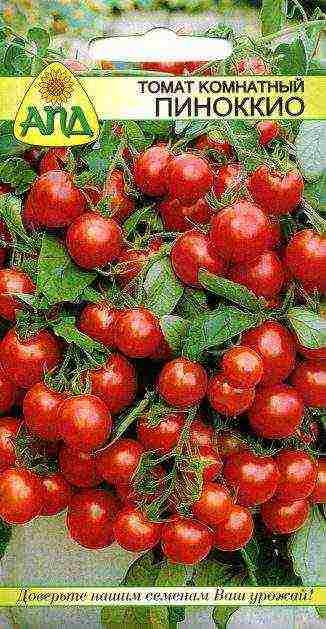 Tomato variety "Pinocchio"
Tomato variety "Pinocchio"
This variety is versatile - suitable for preservation, decoration of dishes or fresh consumption.
Ruby
Early ripe (100-110 days pass before the first tomatoes), standard, undersized variety. Suitable for indoor cultivation. Determinate bush, grows up to 80 cm, does not require pinching and garter. Fruits are round, very dense, fleshy. Ripe tomatoes of a ruby hue. The average weight of one tomato is 80-90 grams. The variety is suitable for all types of processing, but is most often used for making tomato paste. Known for its transportability and long shelf life.
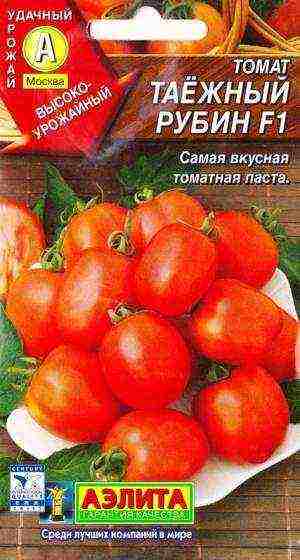 Tomato variety "Ruby" Bonsai
Tomato variety "Ruby" Bonsai
Mid-season (105-115 days from germination to the first harvest), standard, undersized variety. Designed for growing in a pot at home. The bush is determinate, grows up to 20-30 cm in height, does not need support and pinching. The fruits are large (for indoor tomatoes), dense, round in shape. Ripe tomatoes are bright red and weigh about 30 grams (can grow up to 65 grams). They have a sweet taste. The variety is considered a salad variety, because has good taste. Up to 2 kg of tomatoes can be harvested from one plant if properly processed.
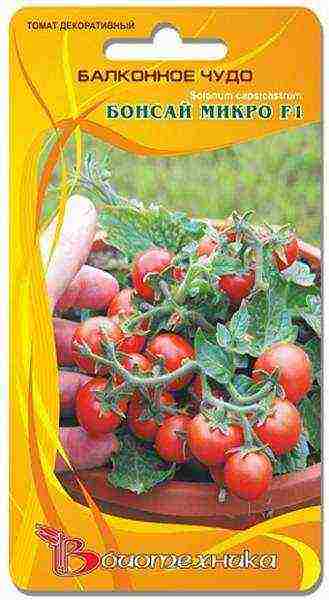 Tomato variety "Bonsai" George Bush
Tomato variety "Bonsai" George Bush
Standard, undersized variety. Ideal for indoor or outdoor cultivation during the warm season. The plant is determinate, it can grow up to 50 cm in height. ... The bush is decorative and looks good. The fruits are round, firm, sweet.
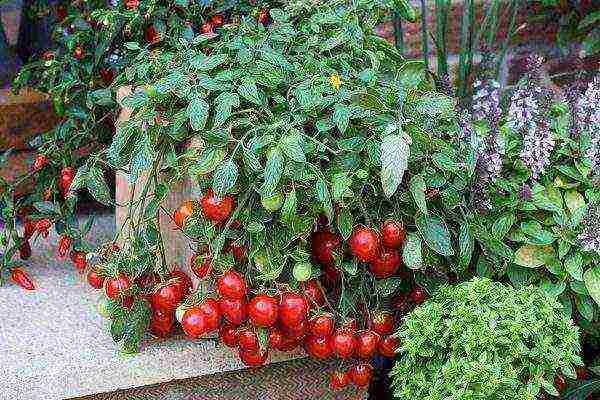 Tomato variety "George Bush"
Tomato variety "George Bush"
Does not need garter, shaping and pinning
Canada News
Determinate, undersized, standard tomato variety. Designed for growing on balconies, window sills or in winter greenhouses. The height of the bush can reach half a meter. The stem resembles a small tree and does not need a garter or pinch. Like all indoor tomatoes, it looks like an ornamental plant. Fruits are round, small, firm, with a sweet taste.
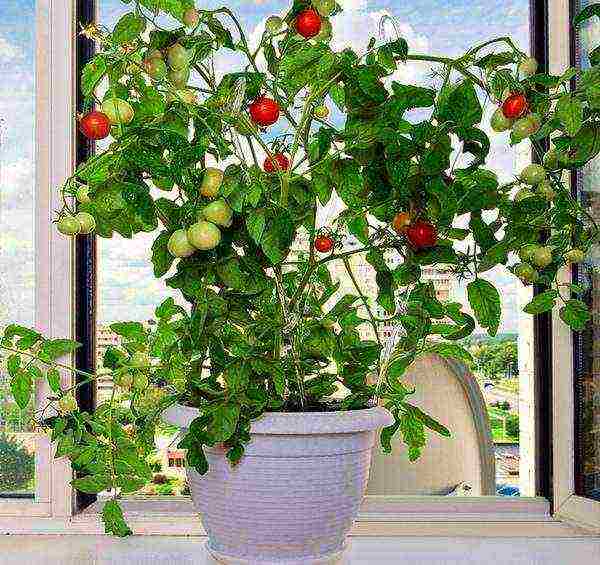 Tomato variety "Canadian News" Japanese indoor
Tomato variety "Canadian News" Japanese indoor
Mid-season (110-120 days from planting to the beginning of the harvest), undersized, standard variety. Bred for growing at home. The bush is determinate, 6-8 fruits are formed on the brush. Round shaped tomatoes, small, firm, sweet taste... Ripe fruits are red and weigh up to 50 grams.
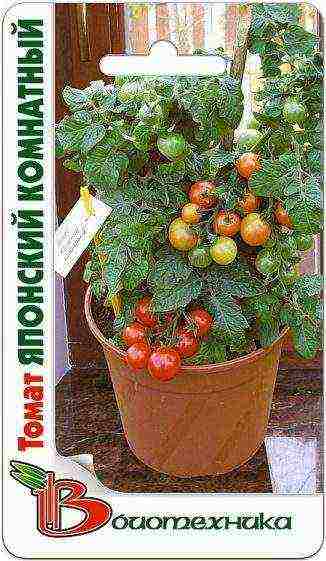 Tomato variety "Japanese indoor"
Tomato variety "Japanese indoor"
The variety is suitable as a dessert or for canning whole fruits. The plant has a very decorative look.
Red Robin
Early ripening (87-95 days before the first tomatoes), standard variety. Designed for indoor cultivation, but can be planted in open ground as a seal plant. The bush is determinate, compact, 20-30 cm high, very beautiful and decorative. The fruits are round (resemble balls), small, weighing up to 20 grams. Have a sweet taste... The plant is shade-tolerant. Tomatoes are used both fresh and for preserving or decorating dishes.
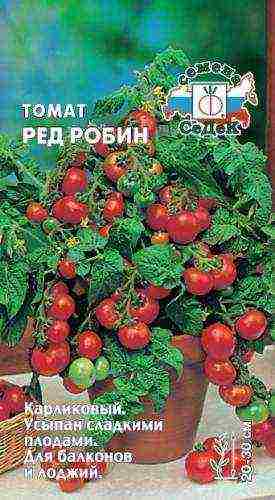 Tomato variety "Red Robin" Semko-Sindbad
Tomato variety "Red Robin" Semko-Sindbad
Early ripening variety (85-90 days before fruiting). Recommended for growing in foil greenhouses or as a houseplant. Determinate bush, grows up to 50 cm, does not require support and pinching. 6-8 fruits grow on one bunch. Tomatoes are round, smooth, matte, sweet. Ripe fruits are colored red and weigh an average of 80-90 grams... The purpose of the variety is universal - fresh salads, preserves, decorative decoration. The yield from one plant can reach 2-3 kg with proper processing.
The variety is resistant to diseases and viruses. It ripens very early and gives a rich harvest.
Video
conclusions
Thanks to the development of many areas of life, now we can have our own home harvest of vegetables all year round. And for this it is not necessary to have a summer cottage, a vegetable garden or a greenhouse. It is enough to make a little effort, and you can have your own balcony fruitful garden. Of course, any agricultural crop requires care and attention, no matter where it grows - in the usual vegetable garden or in a pot on the windowsill. But not all people live near their land plots and opportunities to care for the future harvest. Therefore, for many modern people, it is times easier to keep track of plants at home. And the biggest plus of such tomatoes is that they grow well in winter. This way, you will have fresh and tasty tomatoes for any occasion or just a snack.
